Cirroctopus
Michael Vecchione and Richard E. Young- Cirroctopus antarctica (Kubodera & Okutani, 1986)
- Cirroctopus glacialis (Robson, 1930) (Robson, 1930)
- Cirroctopus hochbergi O'Shea, 1999
- Cirroctopus mawsoni (Berry, 1917)
Introduction
Members of this family are more muscular than is typical for cirrate octopods. The fins are extremely large and the eyes tilt dorsally. Members of the genus are restricted to high latitudes of the southern hemisphere. Cirroctopus is probably the most distinctive of the four opisthoteuthid genera.Characteristics
- Arms and web
- Suckers not enlarged in males.
- Cirrus length comparable to largest sucker diameter.
- Web nodules absent.
- Fins
- Fins long (greater than body width) and very broad.
- Mantle cavity
- Mantle septum fused posteriorly with mantle wall. (This is a unique feature within the Octopoda.)
- Gill (photograph above right) with half-orange appearance and with characteristic zig-zag arrangement of secondary lamellae.
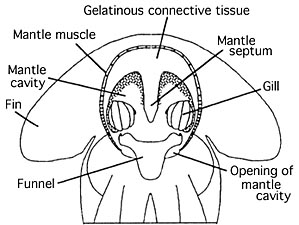 image info
image info
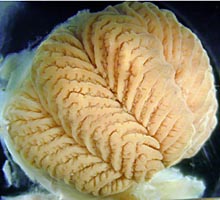 image info
image info
- Digestive tract
- Caecum nearly equal to or much larger than stomach.
- Intestine long (ca. 2.5 times esophagus length) with a variety of right-angle turns.
- Unilobular digestive gland.
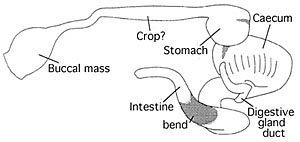 image info
image info
The drawing on the left shows the digestive tract with the complex orientation of the intestine. The label "bend" indicates a sharp bend in the intestine toward the viewer that isn't otherwise clearly apparent. - Nephridial sacs
- Nephridial sacs extensive.
- Nephridial sacs with glandular lining on walls of sacs in additional to renal appendages.
- Pigmentation
- Areolar spots present in young and near eyes and base of fins in adults.
- White body, optic lobe and optic-nerve tract
- White bodies meet in dorsal midline.
- Numerous optic nerve bundles penetrate white body.
- Optic lobe kidney-shaped in cross-section.
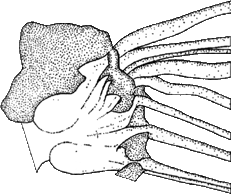 image info
image info
- Shell
-
Shell V-shaped with long wings and short saddle.
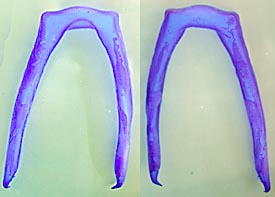 image info
image info
The shell in the photographs on the left have been stained with methylene blue.
Comments
The four species of the genus are poorly differentiated at present. Although a few potentially differentiating characters are known, identification must rely heavily on geographic location until the species are better known.Diagnosis
Opisthoteuthids with:
|
|
Distribution
| Species of Cirroctopus are known only from Antarctic and Subantarctic waters.
Blue dots: C. hochbergi |
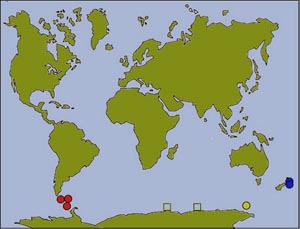 image info image info
|
References
O’Shea, Steve. 1999. The Marine Fauna of New Zealand: Octopoda (Mollusca: Cephalopoda). NIWA Biodiversity Memoir 112: 280pp.
Vecchione, M. and R. E. Young. 1997 Aspects of the functional morphology of cirrate octopods: locomotion and feeding. Vie Milieu 47(2):101-110.
Voss, G. L. and W. G. Pearcy. 1990. Deep-water octopods (Mollusca: Cephalopoda) of the Northeastern Pacific. Proc. Calif. Acad. Sci. 47: 47-94.
Title Illustrations
Grimpoteuthis sp. (left, lateral view, photograph by E. McSweeny) and Grimpoteuthis glacialis (right, ventral view, drawing from Vecchione and Young, 1997).
Other illustrations
- Diagram of G. glacialis with the ventral wall of the mantle cavity removed to show fusion of the mantle septum with the posterior mantle wall. Drawing from Vecchione and Young, 1997.
- Ventral view of preserved gill of G. glacialis. Photograph by R. Young.
- Lateral view of digestive system of G. glacialis. Drawing from Vecchione and Young, 1997.
- Optic lobe with optic nerve bundles penetrating white body of G. hochbergi. Drawing from O'Shea, 1999.
- Dorsal and ventral views of the shell of G. glacialis. Photograph of stained, preserved shell by R. Young.
- Distribution map. Modified slightly from O'Shea (1999).
About This Page
National Marine Fisheries Service
Systematics Laboratory
National Museum of Natural History
Washington, D. C. 20560
USA
Richard E. Young
Dept of Oceanography
University of Hawaii
Honolulu, Hawaii 96822
USA
Page copyright © 2003 and Richard E. Young
- First online 13 May 2003
Citing this page:
Vecchione, Michael and Young, Richard E. 2003. Cirroctopus. Version 13 May 2003 (under construction). http://tolweb.org/Cirroctopus/20103/2003.05.13 in The Tree of Life Web Project, http://tolweb.org/








